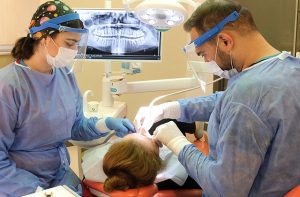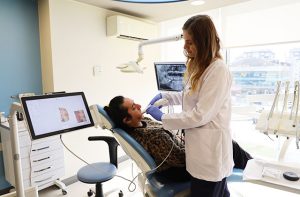Endocrown
When a tooth that has undergone root canal treatment loses its support due to decay, endocrown procedures are preferred to prevent the tooth from breaking and to restore the remaining tissue to its original condition.
4.1. What is an Endocrown?
Endocrown procedures involve the restoration of the tooth by using the remaining space in the root canal after it has been cleaned during a root canal treatment. This process not only preserves the remaining tooth structure but also provides the necessary mechanical support through the root, preventing the tooth from breaking in the future. Additionally, by using special scanning measurements, the restoration is produced as a single piece, ensuring complete integration with the tooth tissue. Not only the surface area covered by the filling but also the deeper parts of the tooth are supported, increasing the tooth’s resistance to applied forces. In this way, support is gained from both the outer and inner parts of the tooth, and aesthetic restorations are made while preserving the natural tissue.
4.2. What Are the Advantages of Endocrown Treatments?
Endocrowns prevent additional tissue loss and allow for aesthetic restorations. They prevent future breakage and damage to teeth that have undergone root canal treatment. The treatment is advantageous in terms of treatment duration and ease of application. Endocrown treatments offer a healthy option for teeth that cannot be fully crowned for various reasons. They also make it easier to clean the restored teeth.
4.3. How Is the Preparation Phase of Endocrown Restorations?
For teeth that have successfully undergone root canal treatment, measurements are taken using 3D scanners and transferred to a computer. The appropriate material, such as porcelain, is then selected according to the treatment plan, and color compatibility is checked. The restoration information and digital measurements are sent to the laboratory, where a digital design is made, and the endocrown is produced and transferred to the clinical environment.
4.4. How Are Endocrown Applications Performed?
In the first clinical application, teeth that have undergone root canal treatment are checked through clinical and radiological examinations. If previous restorations are present, they are removed in the clinical setting, and space is created for a new cavity and endocrown. Measurements are taken using 3D scanners and transferred to computers. The appropriate material, such as porcelain, is selected, and color compatibility is checked. The digital design and measurements are sent to the laboratory. To ensure the process proceeds smoothly, the teeth are temporarily sealed. The specially designed endocrowns are then checked on the tooth for compatibility, and edge fitting and height are also tested. Once everything is in place, the endocrowns are permanently bonded to the teeth, and the treatment is completed. To achieve healthy and long-lasting results, routine dental check-ups are recommended.







